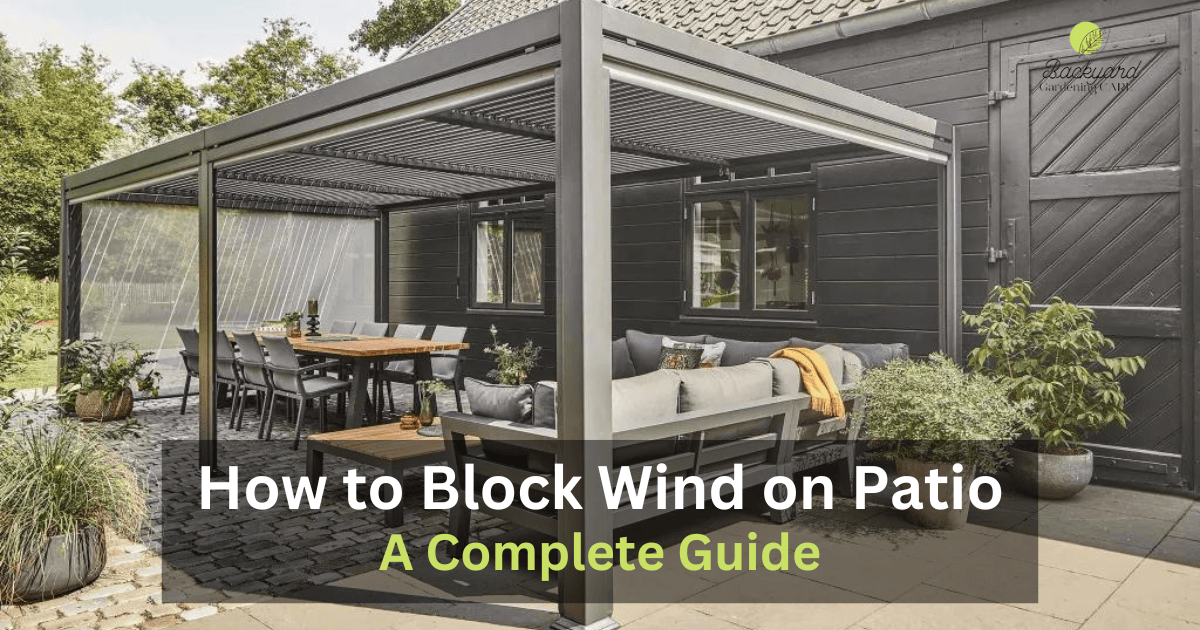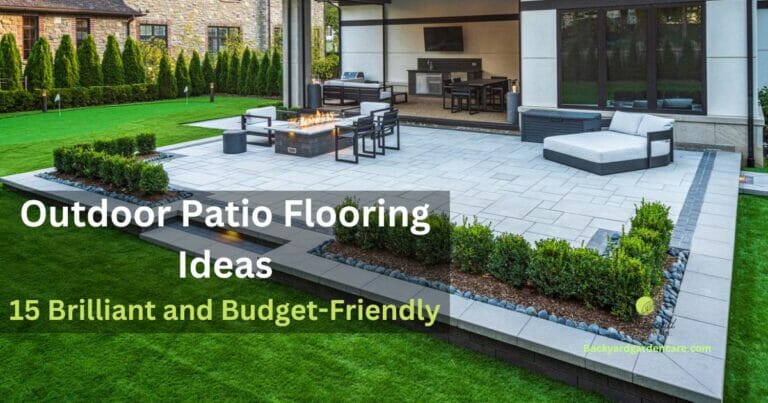How to Block Wind on Patio? 7 Right Wind-Blocking Solution for Your Patio.
Constantly chasing after flying leaves and struggling to keep your furniture upright can quickly turn a relaxing outdoor space into a frustrating chore. If your balcony or patio is too windy for comfort, you know the struggle too well.
Many people find the wind to be a major inconvenience when it comes to enjoying their outdoor space. Let’s explore some creative ways to block wind on your balcony or patio; these strategies and practical tips will help you block wind effectively.
So, if you’re tired of being blown away, keep reading to discover how to block wind on patio.

Understanding the Importance of Blocking Wind on Your Patio
There are many elements that homeowners consider when it comes to creating the perfect outdoor space, and some of these elements include comfortable furniture, valuable rocks for beautiful landscaping, and ambient lighting.
While these are all important considerations, one important factor that often gets overlooked is blocking wind on your patio. Blocking wind on your patio is crucial in creating a pleasant and enjoyable outdoor living area. In this part, we will explore the reasons why wind protection is important.
1. Enhancing Comfort
One of the main reasons to block wind on your patio is to enhance overall comfort. Wind can significantly affect the comfort level of your patio.
Even a gentle breeze can make it feel cooler and cause discomfort, especially during cooler seasons. Strong gusts of wind can make it difficult to enjoy your outdoor space, causing discomfort and making it challenging to relax. Additionally, frost can also impact on your outdoor grass, adding to the challenges of maintaining a comfortable and appealing outdoor environment.
Blocking the wind can create a more comfortable environment for yourself and your guests. This allows you to fully enjoy your patio without the discomfort of cold & hot gusts.
2. Extending the Usable Space
A patio that is constantly exposed to strong winds may not be fully utilized throughout the year. Frequently, you will not be able to spend much time outside due to windy conditions, which may force you to spend most of your time indoors.
By installing wind-blocking elements, you can extend the usability of your patio, making it a useful space year-round. This means more opportunities for outdoor entertaining, relaxation, and spending quality time with family and friends.
3. Protecting Outdoor Furniture

Another important reason to block wind on your patio is to protect your outdoor furniture. Wind can cause damage to your outdoor furnishings and decor. Strong winds can cause damage to fragile items such as glass tabletops, lightweight chairs, and delicate accessories.
By implementing plexiglass wind barriers, you can shield your furniture from the forceful impact of wind, prolonging its lifespan and saving you money on replacements, and also save your patio from unwanted pests and bugs while ensuring that your patio remains visually appealing and inviting.
4. Creating a Cozy Atmosphere to Understand How to Block Wind on Patio
If the patio is shielded from the wind, it can provide a cozy and intimate atmosphere as it is sheltered from the elements. In this way, using wind blocks, you create a feeling of enclosure that can add a sense of depth to your outdoor space, making it feel more like a part of your home.
This can be achieved through various methods, such as installing pergolas, building walls or screens, or utilizing outdoor curtains. These additions not only block the wind but also add an element of privacy and create a cozy outdoor sanctuary. properly anchoring a pergola is a beautiful addition to any outdoor space, providing both shade and architectural interest. Adding a pergola to your outdoor space adds aesthetic appeal and provides a functional space for relaxing or entertaining.

5. Reduce Noise
Wind can generate unwanted noise, especially when it whistles through gaps or rattles objects on your patio. It is important to remember that noise pollution can interfere with conversations, relaxation, and any other outdoor activities you might be engaged in.
By blocking the wind, you can reduce the noise level on your patio and create a more peaceful and serene environment.
6. Protection from the Elements
Other weather elements accompanying wind, such as rain, snow, or sand, can make the wind even more hostile. Blocking the wind can provide a barrier against these elements, allowing you to use your patio regardless of the weather conditions.
This means you can extend your outdoor living season and make the most of your patio space year-round. Remember, when implementing wind-blocking measures, it’s essential to strike a balance between protection and ventilation.
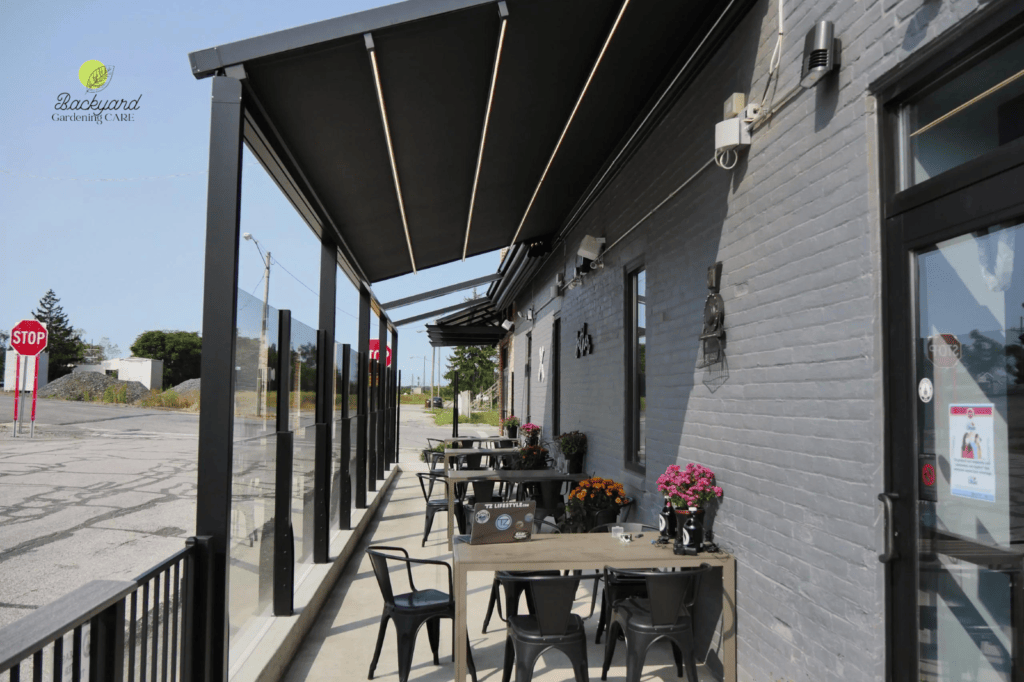
While blocking wind is important, you still want to allow for natural airflow to prevent stagnation and maintain a pleasant outdoor environment. Understanding the importance of blocking wind on your patio is crucial for creating a comfortable, unwanted pest-controlled and functional outdoor space.
By implementing wind-blocking measures, you can create a more comfortable atmosphere where you and your guests can fully enjoy your patio, regardless of the weather conditions.
Choosing the Right Wind-Blocking Solution for Your Patio
Choosing the right wind-blocking solution for your patio is crucial for creating a comfortable outdoor space. Personally, I’ve faced the frustrations of strong gusts of wind disrupting outdoor gatherings and making it challenging to enjoy the patio. It often resulted in shivering guests and objects flying around.
On the other hand, a friend of mine shared his experience of selecting the perfect wind barrier. They installed plexiglass panels, which not only protected their patio from the relentless wind but also kept it cozy and bug-free, making evenings spent there truly enjoyable.
It’s clear that the right wind-blocking solution can make a world of difference in maximizing the use and comfort of your outdoor space.
1. Windscreen Fence
If you are in need of effective wind protection for your patio, consider installing windscreen fences. These versatile solutions are suitable for both residential and commercial settings, providing comprehensive coverage and various benefits.
By installing a windscreen fence, you can enjoy increased privacy while significantly reducing the amount of wind that enters your outdoor space. This is especially beneficial for low patios in spacious backyard areas with additional land.

Whether you are seeking a solution for your home or a construction project, windscreen fences offer an excellent way to create a more comfortable and protected outdoor environment.
In commercial settings, windscreen fences can enclose outdoor dining areas, create private spaces in hotel or resort settings, or even provide temporary wind block barriers at large construction sites. Their versatility makes them an ideal choice for various industries and applications.
Customization Options
Windscreen fences offer a range of customization options, allowing you to tailor the design to your preferences and requirements. If you are looking for a windscreen that complements your existing outdoor aesthetic, you can choose the screen’s colour, height, and material.
Furthermore, some windscreen fences are designed to be easily removable, providing you with the flexibility to adjust the level of wind protection as needed. This is particularly useful in situations where you may want to enjoy the natural breeze during calm weather but have the option to shield your patio during windy conditions.
2. Potted Plants

When reducing wind in outdoor spaces such as patios and balconies, many people opt for wind-blocking methods using plants and shrubs.
The use of potted plants is one effective method that has proven to work very well in improving the aesthetic value of these areas. Concrete pots have been shown to be the most effective among different types of pots.
The strength and durability of concrete pots make them capable of withstanding high winds. This is particularly important in areas where strong winds are common. Using concrete pots gives you peace of mind knowing that your plants will remain stable and secure even during gusty weather conditions.
In addition to their strength, concrete pots are also considered to be better for plants. They provide a stable and well-insulated environment for the roots, allowing them to grow healthier and stronger.
The insulation properties of concrete pots help protect plants from extreme temperatures, which is beneficial for their overall growth and development.
You can create a DIY wooden planter bracketed to the patio floor if you prefer a more customized approach. This type of planter ensures that the plant remains upright and stable, preventing it from toppling over in windy conditions. It adds a touch of uniqueness to your outdoor space while also providing effective wind protection.
Choosing plants of the desired height is important to maximize wind protection’s effectiveness. Opting for taller plants will ensure that they can effectively block the wind and create a shielded area.
It’s best to select bushy plants or trees such as mini Cyprus trees, bamboo plants, or similar options to effectively block the wind. These types of plants will provide a denser and more effective barrier against the wind.
Moreover, setting the plants up close together will further enhance their ability to keep the wind out, providing a more comfortable and enjoyable outdoor experience. Overall, using potted plants as a wind-blocking method on your patio or balcony can significantly enhance your outdoor living experience.
3. Glass walls
Glass walls surrounding patios are becoming increasingly popular due to their versatility and aesthetic appeal. Not only do they serve as effective clear wind blocker for patio, but they also add a touch of elegance and luxury to outdoor spaces.

These walls are typically constructed using thick, strong glass panels that are attached to a sturdy metal frame, which can be drilled into the patio’s floor and walls for added support.
Whether a full glass wall or just a section of the deck with a glass railing, the result is a smooth and modern look. Maintaining glass walls is relatively simple. You can easily clean the panels using water and soap or opt for window cleaners for a streak-free finish.
The transparency of the glass allows ample natural light to enter your patio while still providing clear views of the surrounding landscape. This means you can enjoy the beauty of your outdoor space without being affected by strong winds.
The main purpose of glass walls is to block out wind while still allowing ample natural light to flood the space. This feature ensures that you can comfortably enjoy your patio even on windy days, as the glass walls provide a barrier against gusts of wind.
Meanwhile, the transparency of the glass allows you to take in the beautiful views surrounding your outdoor area. Moreover, modern glass walls come in a variety of styles and features to suit different preferences and design schemes.
Choosing sliding glass walls for patio enclosure is popular, as they provide flexibility for opening and enclosing the space. Other styles may include folding glass walls or pivot glass walls, which provide additional options for customization.
Overall, glass walls are an excellent choice for those looking to add both functionality and style to their patios. With their ability to block wind, allow natural light, and showcase breathtaking views, these walls offer a versatile and elegant solution for outdoor spaces.
4. Wooden Fences
There is no doubt that wooden fences can add an inviting aesthetic appeal to your patio, as well as provide the necessary functionality of blocking wind and ensuring privacy at the same time.
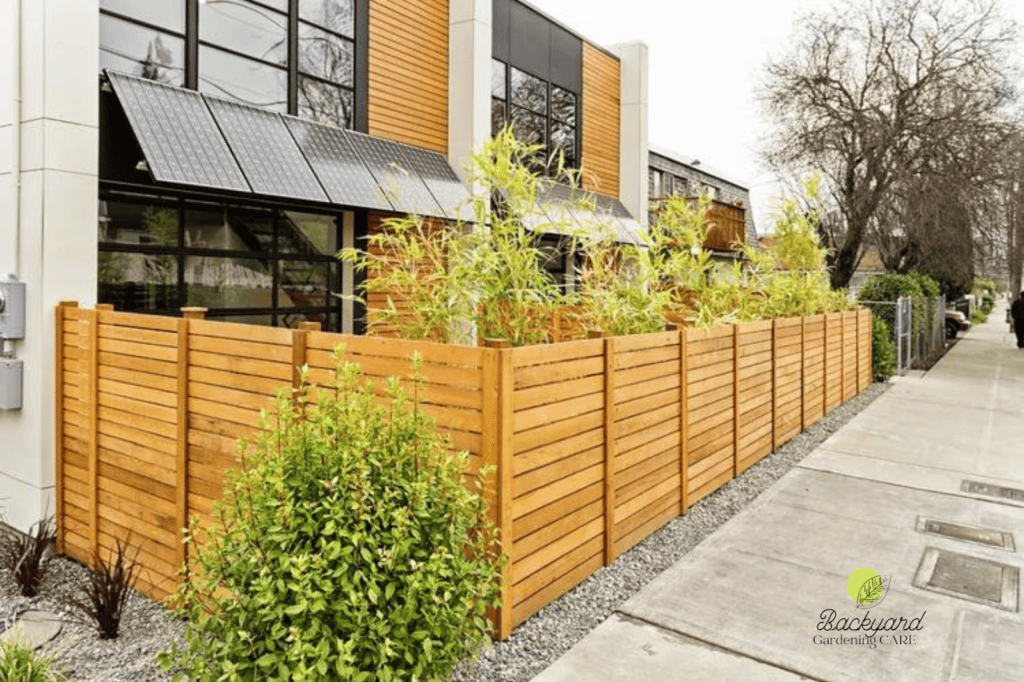
You can customize your fence to suit your preferences with various options available. One of the main benefits of wooden fences is their ability to keep the wind out.
Whether you’re looking to create a cozy outdoor space or protect your patio furniture from strong gusts, a wooden fence can act as an effective windbreak. By reducing the amount of wind that blows into your patio, you can enjoy a more comfortable and enjoyable outdoor experience.
You have several options when choosing the right wooden fence for wind protection. Firstly, you can select the type of wood that best suits your needs. Different types of wood offer varying degrees of durability and resistance to weather conditions.
Cedar and redwood, for example, are known for their durability and natural resistance to rot and decay. Choosing sturdy and weather-resistant wood will ensure that your fence can withstand the elements and serve its purpose effectively.
Furthermore, you can also choose your fence style for the type of wood. Vertical bars with a matte finish can be used to create a more traditional and rustic look, while horizontal bars with a glossy appearance can create a more modern and sleek look.
The style you choose will largely depend on your personal preferences and the overall aesthetic of your patio. It’s important to keep in mind that the main purpose of installing a wooden fence on your patio is to reduce wind exposure. As such, you should narrow down your options and select the most suitable and practical design for this specific purpose.
Consider factors such as the height and thickness of the fence and any additional features like lattice or trellis panels that can provide extra wind protection. Overall, wooden fences offer both functionality and beauty for your patio. They can effectively block wind, creating a more comfortable outdoor space while also providing privacy.
5. Wind Screen
A windscreen is essentially a fence made of a strong and durable net material that can be attached to wooden or metal panels. This fence can be built around your patio area to keep the winds at bay and prevent them from interfering with your normal activities and enjoyment on the patio.
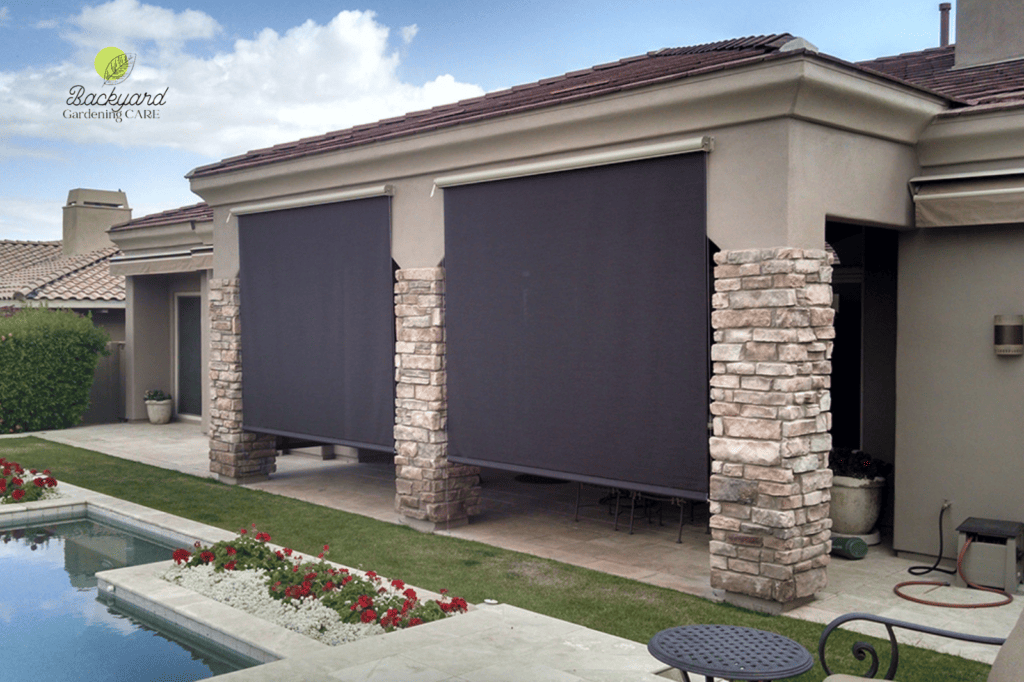
One of the great things about windscreens is that they are also highly resistant to fading, which makes them the perfect choice for homes. This means that even in hot, sunny weather or heavy rains, the fence will still look great and last for a long time.
These fence screens are typically made of high-quality, long-lasting, water-resistant materials, so you don’t have to worry about them getting damaged in inclement weather.
Windscreens have special properties that let them resist powerful winds and withstand a variety of weather conditions. This is especially important if you live in an area prone to strong winds or frequent storms.
Typically, windscreens are about 3 feet tall, which is the perfect height to provide shade and protection from the wind without completely blocking the view. They are also available in various colours and styles, so you can choose one that matches your patio decor and personal aesthetic.
Installing a windscreen is a relatively simple process that can be done by a professional or even as a DIY project. Once installed, you will immediately notice a difference in the comfort and usability of your patio.
6. Retractable Wind Block for Patio
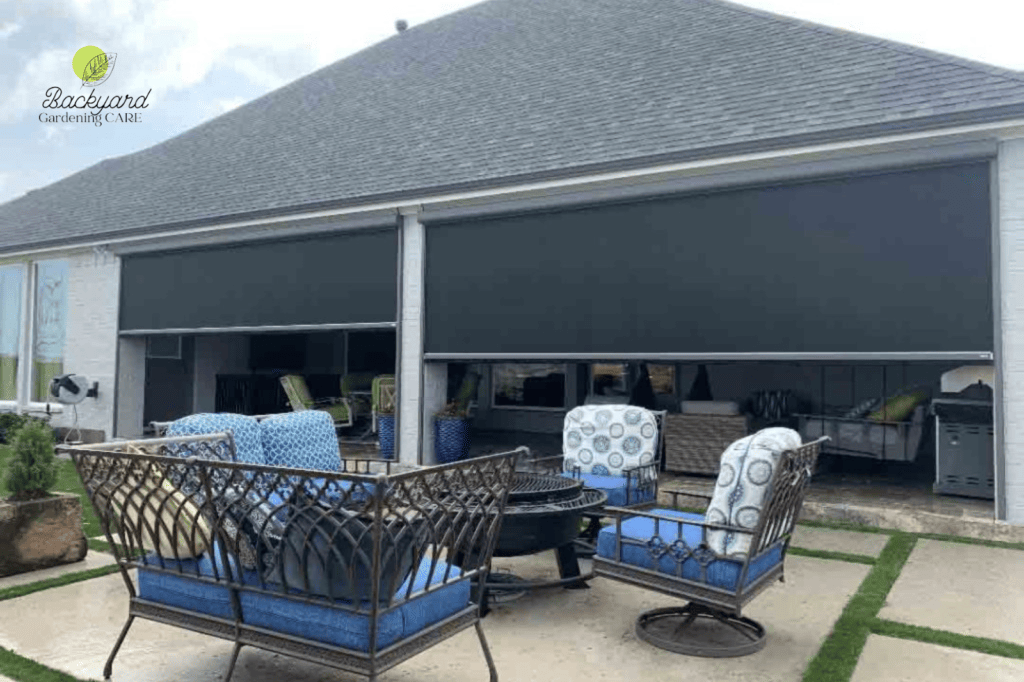
Finding the perfect balance between functionality and aesthetic appeal is paramount in outdoor living spaces. One such solution that offers both is the retractable side screen. Unlike traditional roller shades that operate vertically, this innovative design runs horizontally, making it a perfect choice for those seeking to shield themselves from the wind.
With the ability to securely screw down the support poles, this side screen offers a stable and durable solution. However, it is important to note that while it can provide effective protection against mild to moderate winds, it may not be suitable for areas prone to strong winds.
Therefore, assessing the wind conditions in your location and considering alternative options if you frequently experience high winds is crucial. In terms of versatility, the retractable side screen can be utilized in various outdoor settings.
The screen typically attaches using a simple hook mechanism, which, although convenient, may not hold up well in extreme weather conditions. So, if you’re in search of a flexible wind-blocking solution for your balcony or patio, a retractable side screen could be just what you need.
7. Vines Climbing On Trellises
Are you looking for a way to block the wind on your patio while adding beauty and shade? Look no further than installing trellises and training climbing vines to grow on them.

Not only will this create a visually appealing addition to your outdoor space, but it will also serve as a practical solution for blocking wind and sunlight. Trellises provide the perfect support system for climbing vines and shrubs, allowing them to grow and flourish.
By incorporating climbing vines onto your trellises, you can create a stunning visual display while enjoying the benefits of wind protection. A wide variety of fast-growing vines are perfect for training on trellises.
Climbing roses, clematis, passionflowers, grapes, trumpet vines, and bougainvillea are just a few examples of the many options available to you. These vines not only have the ability to add beauty to your outdoor space with their vibrant blooms but also have the capacity to effectively block wind on your patio.
Imagine sitting on your patio, surrounded by the lush foliage of climbing roses or the vibrant colors of bougainvillea, while enjoying a peaceful and wind-free environment.
You can shield your backyard from strong winds using trellises and climbing vines to create a private oasis. This can make your patio more comfortable and enjoyable, allowing you to fully relax and unwind.
So, whether you’re looking to block wind, add shade, or enhance the aesthetics of your patio, installing trellises and training climbing vines is a fantastic solution.
Final Thoughts
Blocking wind on your patio is a practical and effective way to enhance your outdoor experience. By implementing the strategies and techniques discussed in this guide, you can create a comfortable and enjoyable space shielded from strong gusts of wind.
Whether you opt for physical barriers like fences or walls or utilize natural solutions such as plants and trees, there are various methods available to suit your preferences and needs.
Consider your patio’s specific layout and design and the prevailing wind direction when choosing the most suitable wind-blocking solution.
Remember to maintain a balance between wind protection and maintaining airflow to ensure a pleasant and functional outdoor environment. With some planning and effort, you can transform your patio into a peaceful oasis where you can relax and entertain, even on breezy days.
FAQs
What is the Best Way to Block Wind?
One effective way to block wind is by using windbreakers or windscreens. These can be constructed using canvas, mesh fabric, or solid barriers like wooden fences or walls.
Strategically placing these wind blockers in areas where the wind tends to be strongest, such as along the perimeter of outdoor spaces or near windows, can significantly reduce the amount of wind that reaches you.
Furthermore, planting dense shrubs or trees can act as natural windbreaks, providing aesthetic appeal and protection from strong winds.
How Do You Wind Proof a Balcony?
To windproof a balcony, you can take a few key steps. First, install windbreakers or privacy screens along the edges of the balcony to block strong gusts. These can be made of materials like glass, metal, or fabric. Additionally, consider adding windproof curtains or blinds to any open sides of the balcony.
These can be made from weather-resistant materials and can be easily rolled up or down depending on the weather conditions. These can be drawn closed during windy weather to minimize drafts.
What Material is Wind Protection?
The material used for wind protection can vary depending on the specific application and desired level of protection. Common materials include heavy-duty fabrics such as nylon, polyester, or polyethene, which are often used for windbreaks, windproof jackets, and tents.
These materials are known for their durability, water resistance, and ability to block wind. Other options may include specialized windproof membranes or laminates designed to enhance windproofing properties while allowing breathability.
Structures such as walls, fences, glass walls, windscreens, or hedges made of wood, concrete, or metal can also provide effective wind protection. Ultimately, the choice of material will depend on the specific needs and conditions of the wind protection project.
Albert Phipps

Hello, I’m Albert Phipps, your trusted professional gardener. I have a deep passion for nurturing nature’s beauty, With years of experience in landscaping. I’m dedicated to creating lush, vibrant gardens and outdoor spaces.
If you’re seeking guidance on plant selection, grass care, pest control products, garden design, or lawn maintenance tips, don’t hesitate to get in touch. I’m here to help you transform your outdoor space into a thriving and serene landscape.

